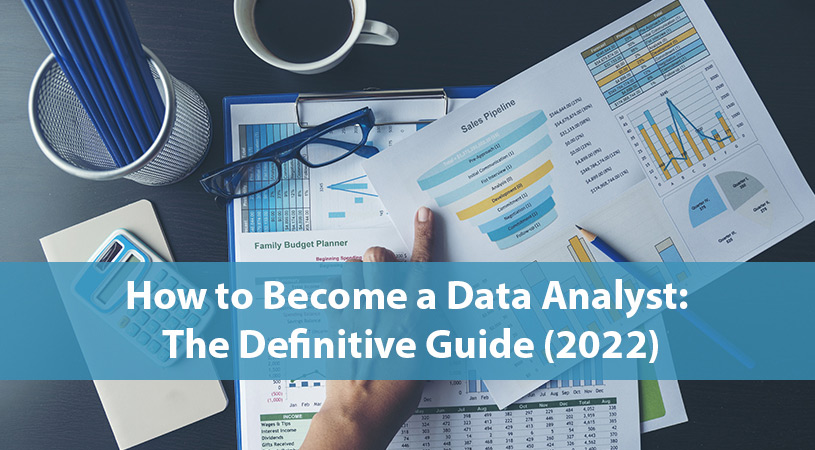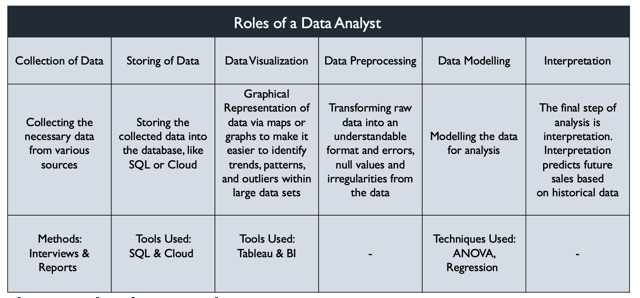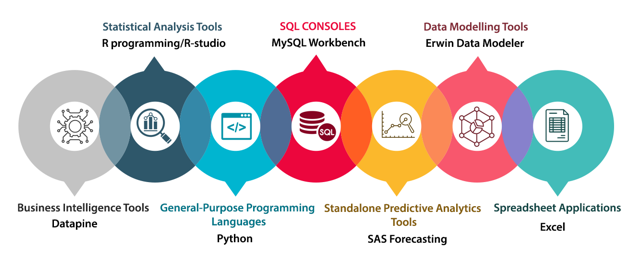So, you're planning to start your career in data analytics, but you are confused about:
- Where to start your journey?
- Which tools to learn?
- What techniques and subjects to focus on?
- Do you need to know to code?
- And most importantly, what is the career growth in data analytics?
Well, if these are your concerns, no worries - We have got you covered.
And that's why we thought we should create this guide. We would love to help you get started in data analytics. This blog will set a framework to help you know everything about data analytics.
What is Data Analytics and Why is It in Huge Demand?
Data analytics refers to using quantitative and qualitative techniques and processes to inspect, cleanse, transform the data to discover useful information. The user extracts, categorizes, stores, and analyzes the data to study trends and patterns in emerging markets. It is to gain a competitive edge over rivals.
Data analytics can help businesses increase their revenues by optimizing marketing campaigns, improving operational efficiency and customer service efforts.
For example, let's say you own a business and sell dairy products.
Let's assume - the biggest challenge for your business is to find the right amount of stock, at the given time. You can not stock excess dairy products as they are perishable. Also, if they have become low in quality, you cannot sell them. And it will result in a direct loss.
At the same time, you cannot understock as it may result in a loss of potential customers. Here, data analytics can help you in predicting the strength of your customer at a given time. By using that result, you can sufficiently stock your supplies, in turn minimizing the loss.
In simple words, data analytics can help you find out the time of the year when your store has the least or most customers. Using this information, you can stock your supplies accordingly.
Why is Data Analytics Emerging in the Current Market?
Data analytics is used to make data-backed decisions and strategies to get the desired business results. Now, in India, data analytics has become a big career option. Businesses have realized the value of utilizing data analytics to increase their profits. They know that data is vital for their growth. Nowadays, all the major business decisions are taken after analyzing the available organization and industry data.
On top of it, competition is on a continuous rise. Customers are flooded with choices, and that's why it has become crucial to understand customer needs with more accuracy. And data analytics provides accuracy. It is based on statistical models that help in fine-tuning and analyzing the data.
Data analytics also renders the answers to existing business problems as well as give a view of future trends. This way, data analytics plays a huge role in preparing the company to make products for the future. And to connect with the customers of tomorrow.
Check out the Top 10 Trends that Would Drive the Scope of Data Analytics.
Who can become a Data Analyst?
Since data analytics is an advanced field of information technology and management, first, you need to complete your graduation with at least 60% marks (preferably in the IT and statistics stream).
Aspiring data analysts should have a degree in Economics, Statistics, Computer Science, Mathematics, or other subjects.
You can become a Data Analyst if you,
- Have time to study.
- Are committed to your goal.
Skills Required to Become a Data Analyst
- To become a Data Analyst, you must have good analytical, statistical, and problem-solving skills.
- Data analytics requires rigorous research and pattern evaluation, so you must also have decent coding knowledge.
- You require data visualization skills to perform well in the market.
- Decision making is another essential skill that you will need to pursue a career as a Data Analyst. With an inclination for problem-solving skills and having an analytical mind, one can easily excel in this field.
Role of a Data Analyst
Data analysts' work revolves around the data. A Data Analyst is someone who turns the raw data into information and information into insights. A data analyst extracts, collects and interprets different sorts of data. He/she scrutinizes the information by using data analysis tools.
And then, he/she pulls out meaningful results from the raw data. It helps the organization or clients in making important decisions.
In a nutshell, a data analysts’ role includes-
- Collecting data from primary & secondary sources & then reorganizing that data in a simple format.
- Using advanced computerized models to interpret and analyze the data.
- Identifying patterns, correlations and trends in datasets.
- Maintaining data systems and databases.
- Preparing reports for managerial leadership that effectively communicate patterns, trends, and predictions using relevant data.
- Collaborating with engineers, programmers, and corporate leaders for process improvements, recommend system modifications, and various other activities.
What Tools Do Data Analysts Use?
To be able to perform data analysis, data analysts use different types of tools and software. Though there are hundreds of tools available in the market, a data analyst must choose wisely. The tools and software should benefit their analytical efforts. Let us talk about some tools that data analysts use.
1. Business Intelligence Tools
These tools are specially designed for business analytics. These tools help data analysts to analyze, monitor and report on crucial findings. Features such as predictive analytics and advanced SQL modes make these tools easily adjustable to every level of knowledge.
Datapine is a popular business intelligence tool. It is focused on delivering simple yet powerful analysis features to data analysts who need fast and reliable online data analysis solutions.
2. Statistical Analysis Tools
Computation techniques often contain a variety of statistical techniques to explore and generate insights. There exist multiple programming languages that make data analysts’ work easier and more effective.
R programming/R-studio is one of the best and most used data analytics tools. It is suitable for statistical analysis for data cleansing, data filtration, and data analysis. R is an invaluable analytical assistant. It covers both general and academic data analysis. It can also perform statistical analysis such as factor cluster analysis, regression, and conjoint, etc.
3. General-Purpose Programming Languages
Data analysts use different programming languages to solve a variety of data problems. A few programming languages used by data analysts include C#, Java, PHP, Ruby, Julia, and Python.
Though data analysts preferably use python. Its open-source solution has simple coding processes and syntax that makes it fairly easy to learn.Python can also be integrated with other languages such as PHP, C#, C/C++, Java, etc.
4. SQL CONSOLES
SQL is a programming language that analysts use to manage data held in relational databases. It is highly popular as one of the analyst tools used in various business cases and data scenarios.
It is widely used in the data analytics field. Most of the data is stored in relational databases, and you need to access and unlock its value.
There are different SQL based relational database management systems. It includes MySQL Workbench, PostgreSQL, MySQL, MS SQL, and Oracle.
MySQL Workbench is the most popular SQL console. Analysts use it to visually design, model, and manage databases, administer MySQL environments, optimize SQL queries, and utilize a suite of tools to improve the performance of MySQL applications. It allows data analysts to create and view databases and objects, configure servers, and much more.
5. Standalone Predictive Analytics Tools
Predictive analytics is an advanced technique. Data analysts who combine data mining, predictive modelling, machine learning, and artificial intelligence to predict future events - use it.
SAS Forecasting is one such tool that has established itself as one of the most prominent data analysis software. It offers a wide range of forecasting methods, including event modelling, hierarchical reconciliation, scenario planning, and what-if analysis.
6. Data Modelling Tools
Data analysts use data modelling tools to discover the exact nature of the information and the relationship between datasets.
Erwin Data Modeler is a very famous data modelling tool used to find, visualize, design, deploy and standardize high-quality enterprise data assets. It also helps to understand and reduce the complexities of data. Plus, it offers automated processes where you can automatically generate models and designs to lower errors and increase productivity.
7. Spreadsheet Applications
A spreadsheet is a traditional form of data analysis. People who do not have high technical skills to code themselves mostly prefer spreadsheets.
Excel is a widely used spreadsheet application. It's a versatile data analytics tool where you can manipulate rows and columns to do your analysis.
From arranging to manipulating, calculating, and evaluating quantitative data to building complex equations and pivot tables, excel has earned its place in traditional data analytics tools.
Conclusion
Data analytics also allows the business to maximize their conversion rates and cut unnecessary costs. With all these obvious advantages, it wouldn't be wrong to say that data analytics is making significant changes in a big economy like India.












